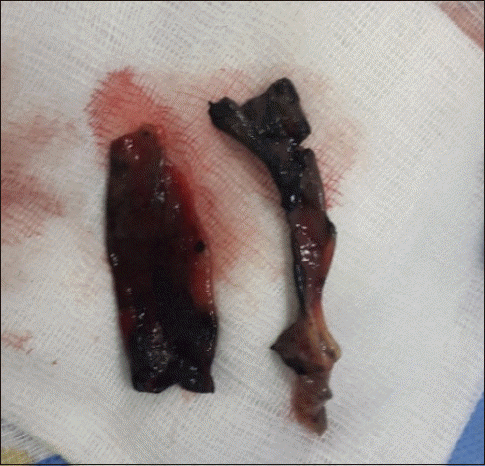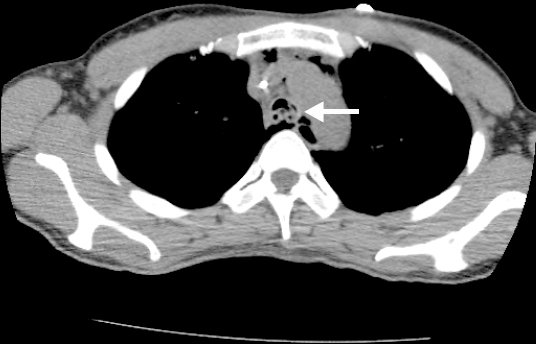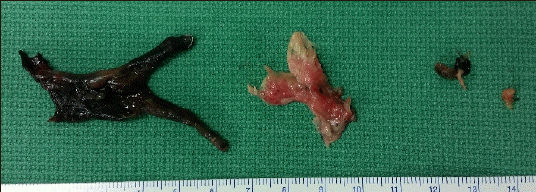A 36-year-old woman was admitted to the emergency department with a suspicion of inhalation burn injury due to a fire at her home. She was drowsy at presentation. Initial arterial blood gas analysis (ABGA) revealed a pH of 7.07, PaCO
2 of 22.4 mmHg, PaO
2 of 123.7 mmHg, HCO
3− of 6.4 mM/L, carboxy hemoglobin of 42%, and an O
2 saturation level of 97% (mask ventilation with oxygen at 15 L/min). She was intubated prophylactically and transferred to the intensive care unit (ICU) for conservative treatment. The day after ICU admission, she showed a near-alert mental state but complained of dyspnea and chest discomfort. Her breath sounds included coarse wheezing and rhonchi. Chest plain radiography revealed peribronchial consolidations in both lungs. During ICU care, airway suction through the endotracheal tube was frequently performed, and her vital signs were stable. However, 5 days after ICU admission, she showed sudden tachypnea and tachycardia. At that time, her vital signs were as follows: blood pressure (BP), 192/111 mmHg; heart rate (HR), 125 beats/min; and respiratory rate (RR), 22 breaths/min. ABGA revealed a pH of 7.10, PaCO
2 of 118.5 mmHg, PaO
2 of 125.2 mmHg, HCO
3− of 36.3 mM/L, and an O
2 saturation level of 97% (mask ventilation with oxygen at 15 L/min). Six minutes after the onset of tachycardia, the patient appeared confused, and fingertip pulse oximetry revealed an O
2 saturation level of 56%. Manual self-inflating bag-mask ventilation was performed to supply oxygen to the patient, but the physician in charge observed high airway pressure via the self-inflating bag mask. The patient’s BP decreased to 76/52 mmHg. We examined the endotracheal tube by using a fiberoptic bronchoscope and found that foreign bodies had almost completely blocked the lumen of the endobronchial tube tip. Removing the foreign bodies was difficult at that time, and the patient’s condition progressively worsened because of respiratory acidosis. Therefore, we decided to perform a tracheostomy instead of changing the endotracheal tube for resolving the airway obstruction. The foreign bodies removed through the tracheostoma were sloughed endobronchial debris, which might have obstructed the endotracheal tube (
Fig. 1). After the removal of the sloughed endobronchial debris through the tracheostoma, the patient’s vital signs were as follows: BP, 127/78 mmHg; HR, 134 beats/min; and RR, 34 breaths/min. ABGA revealed a pH of 7.40, PaCO
2 of 76.9 mmHg, PaO
2 of 112.2 mmHg, HCO
3− of 47.1 mM/L, and O
2 saturation level of 98% (mask ventilation with oxygen at 15 L/min). We assessed the tracheobronchial condition by using a fiberoptic bronchoscope because her breath sounds included coarse wheezing. The bronchoscopy revealed that some debris remained in the tracheal lumen, nearly obstructing it. Chest computed tomography (CT) was used to evaluate the bronchiole. Chest CT revealed that 70% of the airway lumen was obstructed with debris at the level of the carina (
Fig. 2). To restore airway patency, we decided to remove the endobronchial debris under general anesthesia in the operating room. General anesthesia with total intravenous anesthesia (TIVA) was considered because sudden movement of the patient or airway reaction could cause foreign bodies to move deeper into the bronchus during manipulation of the rigid bronchoscope. ECMO use rather than high frequency jet ventilation was decided during the operation because prolonged manipulation of the bronchoscope without ventilation could lead to hypoxia. The target concentration of propofol at the effect site was 2–2.5 μg/ml, and the target concentration of remifentanil was 3.5–4.5 ng/ml during general anesthesia with TIVA. Rocuronium (0.6 mg/kg) was administrated for facilitating rigid bronchoscopic manipulation. Systolic blood pressure was maintained between 100 and 120 mmHg; and diastolic blood pressure, between 50 and 75 mmHg during the intraoperative period. Heart rate was recorded between 65 to 90 beats/min. Oxygen saturation was maintained at 100% throughout the operation. Mechanical ventilation was intermittently applied with a tidal volume of 500 ml and at 12 breaths/min when ECMO was not applied. ECMO was applied for approximately 1 hour, and the venovenous approach through both femoral veins was used. Four pieces of foreign body were extracted by using rigid bronchoscopy. The total anesthesia time was 3 hours 20 minutes. The total operation time was 2 hours 40 minutes. The sizes of the foreign bodies were 7 × 3 cm, 3 × 2 cm, 1 × 0.5 cm, and 0.3 × 0.2 cm (
Fig. 3). Bronchoscopy revealed no bleeding, but dark ash was stacked in both the main bronchus and carina (
Fig. 4). Spontaneous respiration recovered within a few minutes after the administration of sugammadex (4 mg/kg). The patient was transferred to the ICU. ABGA revealed a pH of 7.45, PaCO
2 of 35.0 mmHg, PaO
2 of 113.6 mmHg, HCO
3− of 24.0 mM/L, and O
2 saturation level of 99% (FIO
2 0.5) when she was admitted to the ICU. The following day, the endobronchial tube was removed. On hospital day 24, we confirmed by using bronchoscopy that her bronchus and carina were almost back to their original states (
Fig. 5). She was discharged on hospital day 42, and her outpatient treatment is pending.





